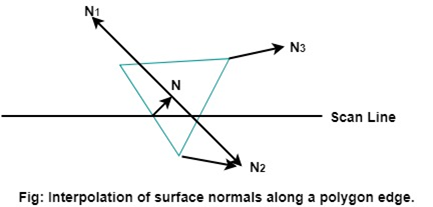Phong Shading
A more accurate method for rendering a polygon surface is to interpolate the normal vector and then apply the illumination model to each surface point. This method developed by Phong Bui Tuong is called Phong Shading or normal vector Interpolation Shading. It displays more realistic highlights on a surface and greatly reduces the Match-band effect.
A polygon surface is rendered using Phong shading by carrying out the following steps:
- Determine the average unit normal vector at each polygon vertex.
- Linearly & interpolate the vertex normals over the surface of the polygon.
- Apply an illumination model along each scan line to calculate projected pixel intensities for the surface points.
Interpolation of the surface normal along a polynomial edge between two vertices as shown in fig:


Incremental methods are used to evaluate normals between scan lines and along each scan line. At each pixel position along a scan line, the illumination model is applied to determine the surface intensity at that point.
Intensity calculations using an approximated normal vector at each point along the scan line produce more accurate results than the direct interpolation of intensities, as in Gouraud Shading. The trade-off, however, is that phong shading requires considerably more calculations.
